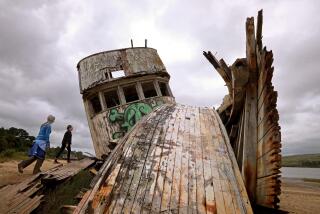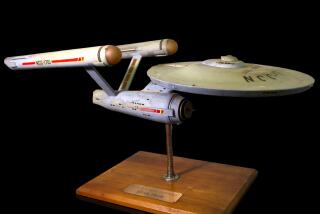Truman’s Presidential Yacht May Be Headed for Troubled Water : History: Ship, now docked in nation’s capital, appears destined for scrap heap. But a Smithsonian employee says it deserves a far grander retirement.
- Share via
WASHINGTON — When he first moved to Washington in 1982, Kim Nielsen lived aboard a houseboat at Columbia Island Marina with a Sunfish sailboat moored astern. Evenings and weekends when the breeze was fair, he would ghost down the Potomac on the little day-sailer, wondering from the water at the monuments of the nation’s history visible all along the shore.
One that lured him for repeated visits was the whitewashed 243-foot hull of a once-grand ship, sagging against its lines at the dock of the Blue Plains Treatment Plant. It was, Nielsen discovered, the Williamsburg, once the presidential yacht of Harry S. Truman.
Winston Churchill and Clement Attlee, among other statesmen, had trod its decks and debated in its salon the fate of postwar Europe. The Williamsburg had carried the President to naval reviews and coastal cruises and served, during the long Key West vacations he favored in those days before Air Force One, as both a movable command center and a floating White House.
A Coast Guardsman before he became chief of photography for the Smithsonian’s Freer and Sackler museums, Nielsen had a feel for ships and their history and was saddened to see the yacht as the derelict and peeling focal point of an ill-fated restaurant scheme for the Georgetown waterfront. There were plans to slice off its top, flood it with water and drag it under the Memorial and 14th Street bridges to a new career.
“I couldn’t believe we would treat such a piece of history like that,” Nielsen said the other day en route to visit the ship again. “People come into the Smithsonian and get excited about George Washington’s teeth! And yet we were treating this much more meaningful relic of our recent past like a piece of trash.”
Little did he know.
Today the Williamsburg appears headed for the scrap heap. The District of Columbia, which has allowed the yacht dock space at Blue Plains for the last eight years, says it is in the way. Pete Hall, manager of Salisbury Towing Co. on the Chesapeake Bay, says that in the name of the District government he has been looking for two years for a yard that will take the ship.
“The problem is, she’s not worth very much where she is,” Hall said. “That channel (to the Blue Plains dock) is silted up and it would be hard to get her out of there. It would cost something like $5,000 to tow her to Norfolk or Baltimore to scrap, and she’s not worth much more than that for the metal once you got her there. There are old ships like her all over the place.”
Well, Hall concedes, not exactly.
Launched in 1931 in Bath, Me., as the $2-million plaything of pulp and paper magnate Hugh J. Chisholm, the Williamsburg was one of the last great yachts of the prewar era. Then known as the Aras, it was almost as long as a football field and had nearly the tonnage of a destroyer: a plutocrat’s vision in black-hulled steel, teak trim and mirror-polished brass. Its diesel engines could push it at 16 knots over a cruising range of 7,500 miles. Its six lifeboats were launches of varnished mahogany, with the name Aras in gold leaf on their sterns. Each member of the 30-man crew was furnished with three different uniforms.
Chisholm cruised the Atlantic Coast and planned to take the yacht around the world, but before he did World War II broke out and the Navy commandeered the ship to help bolster the Atlantic fleet. Renamed the Williamsburg and fitted out with depth charges and three-inch guns, it helped escort Britain-bound convoys on the U-boat-haunted North Atlantic between New York and Iceland.
Meanwhile, the Navy had advised President Franklin D. Roosevelt that his favorite yacht, a 165-foot former Coast Guard cutter named the Potomac, had become dangerously top-heavy with the addition of heavy communications equipment. A keen and lifelong sailor, F.D.R. had use of the shallow-draft 102-foot Sequoia (where Richard M. Nixon later sheltered from the woes of Watergate), but had found the larger vessel more suited both to his wheelchair and to the oceangoing voyages he favored. At the war’s end, the Navy offered the Williamsburg to Truman, his successor.
For all its aristocratic beginnings, the Williamsburg as a presidential yacht assumed the unpretentious character of its chief passenger, the former haberdasher from Independence, Mo. Though its rope-worked gangway railings and gleaming brightwork remained showpieces of shipkeeping, its artificial fireplaces and slipcovered armchairs struck one reporter at the time as reminiscent of those in a contemporary commercial hotel.
Asked where the furniture had come from, one of the officers on the Williamsburg’s shakedown cruise as a yacht replied: “Oh, some of us just picked it up here and there in department stores and places.”
What Churchill and other heads of state thought of it is not recorded, but the man from Missouri found it perfect for the poker parties and fishing trips he favored with his cronies. Since the White House was under renovation for part of his term as President, Truman made unusually frequent use of his yacht for business and entertaining.
It is hard to glimpse all that now in the bedraggled, listing vessel at Blue Plains. Grass, weeds and even small trees sprout from the sodden pulp of once-gleaming teak decks. Beer bottles and cans litter peeling companionways and hydraulic fluid leaks from ruptured lines overhead. Vandals have shattered glass and stripped the ship of bronze, and the stairway to what once was presidential country is now emblazoned “Dolphin Room”--a relic of the ship’s brief but tawdry term during the 1970s as a floating restaurant in Philadelphia.
“The ladies’ room for the restaurant was Bess Truman’s private powder room,” said Kim Nielsen. “The tiled shower, at least, is the same.”
It was Dwight Eisenhower who banished the Williamsburg from presidential favor. Like Lyndon B. Johnson later ordering lights turned off in the White House, he denounced and decommissioned the presidential yacht as an extravagance, then spent $200,000 having two smaller vessels (the Honey Fitz and the Patrick J during the John F. Kennedy Administration) fitted out and named for his grandchildren.
The Williamsburg joined the Navy’s mothballed fleet in Norfolk, but resurfaced in 1962 for a $500,000 refit as a research vessel for the National Science Foundation. Into the presidential lounge went fish tanks and microscopes. Off it went on the four-year, 25-nation International Indian Ocean Expedition, temporarily renamed the Anton Bruun in honor of the noted Danish marine biologist who chaired the first International Oceanographic Commission. The NSF eventually returned to the government, who sold the ship in 1969 to a marina owner in Salem, N.J. There it began a life as a floating restaurant and began the downhill slide to Blue Plains.
Nielsen, who fell in love with the yacht there eight years ago, has been collecting photos and stories about it ever since. He has talked to former crewmen and officers and made diagrams of the decks. He can look beyond the kitschy gold geometric restaurant wallpaper and dank plaid carpet in the salon and see our feisty little 33rd President sitting amid tonier surroundings in his aloha shirts.
He knows it is folly to think the ship will ever return to anything like its glory days as a presidential yacht, but he nurses a vision of some sort of “creative adaptive reuse” of the vessel by the District of Columbia.
“We don’t really have anything historic on our waterfront,” he said. “You could use this as a museum or recreational space. The Potomac River Pilots Assn. has been looking for a place to train student pilots. You could use vocational students to repair the ship--welders to work on the steel, electricians to repair the wires, maybe even diesel mechanics to take apart the engines. If you moored it in the Anacostia, you could involve the community in its restoration and give them something to be proud of, something they did.”
With the sort of energy born of love, Nielsen has even printed up Williamsburg stationery and bombarded D.C. officials and maritime preservationists, pleading for help. So far, he says, it has been a hard sell.
“Everyone says they’re sympathetic, but nobody has any money and nobody in the District government will really take charge. Part of the problem is that she looks like such a wreck. You really have to be a seaman to understand that nearly all of this is cosmetic. The hull is high-grade 2-inch steel, and that’s solid. Even most of the stuff that’s been stolen is basic Navy size. You could buy it cheap from any wrecking yard.”
Just how immediate is the threat from the wrecker’s ball is unclear. Despite persistent rumors of a scrap-it-now order from the D.C. Department of Public Works, DPW spokesman Tara Hamilton says no such order has ever been given.
Virginia Woodyard, a Realty specialist in the real-property administration office of the D.C. Department of Administrative Services, says, in fact, that the District doesn’t even own the Williamsburg.
It is owned, she says, by the Presidential Yacht Trust, a nonprofit organization currently mired deeply in debt amid allegations of financial irregularity involving the recently restored Sequoia.
The trust was notified in November, 1988, that it would have to move the vessel, she said, and last October, citing a lack of success in its search for a buyer, conveyed to the District the authority to dispose of the ship as it wishes.
“We have not accepted responsibility for it,” Woodyard said. “Our position is the trust still has that, and we’d like them to move it. But we do have the authority to dispose of it. The District has not yet determined if we will.”
There is no question, however, that the Department of Public Works wants it moved.
So, in fact, does Nielsen. He’s mindful of the curious fate of other presidential yachts. The Mayflower, which served every President from Teddy Roosevelt to Calvin Coolidge, was last seen smuggling Jewish refugees into Palestine in 1948. The Despatch, which served presidents Hayes, Garfield, Cleveland and Harrison, wrecked on Assateague Island and sold for $160. The Potomac, F.D.R.’s yacht, was owned briefly by Elvis Presley and later sank in San Francisco Bay after a dope raid.
Nielsen wants a grander, more visible retirement for the Williamsburg.
Without it, he said with a sigh, “a hundred years from now, people will have no idea of the scale of what used to be.”
More to Read
Sign up for Essential California
The most important California stories and recommendations in your inbox every morning.
You may occasionally receive promotional content from the Los Angeles Times.













